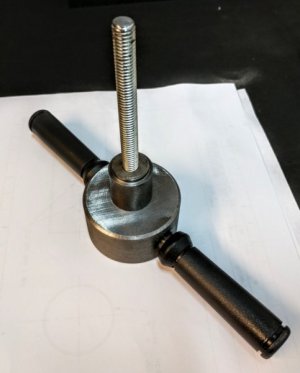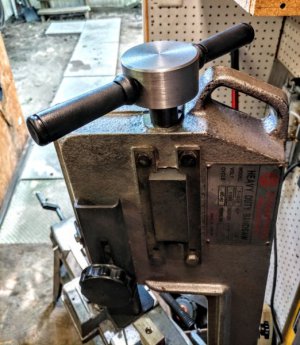That wimpy little plastic knob for tightening the blade on my band saw was too small to get the proper tension on the blade without using the large channel loks. So ....... I made a new adjustment handle using a 2" diameter piece of CRS , drilled and reamed .500" holes for handles 180 degrees apart. I loc-tite the 1/2" rods in the holes, put on a nifty set of rubber grips I had left over from other projects, and loct-tie some 3/8" all thread in a tapped hole.

The handle works great. I can easily tighten the blade to proper tension by hand. This mod only took about an hour to make (looks good too).

The hole in the saw casting was tapered (draft angle) when cast, so I used my 4 1/2" angle grinder to grind it flat so the handle seats properly against the casting.

The handle works great. I can easily tighten the blade to proper tension by hand. This mod only took about an hour to make (looks good too).

The hole in the saw casting was tapered (draft angle) when cast, so I used my 4 1/2" angle grinder to grind it flat so the handle seats properly against the casting.


 . ( I made it from scraps I had). I am actually afraid to tighten the blade to what several blade manufacturer say it should be. The specs say .00034" stretch over a specified distance. I make mine about 2/3 of that spec and it is TIGHT. With the proper tension, the saw cuts straighter faster and a smoother finish. I was amazed how much better my saw performs just with the proper blade tension. This handle made it so much easier to adjust the tension.
. ( I made it from scraps I had). I am actually afraid to tighten the blade to what several blade manufacturer say it should be. The specs say .00034" stretch over a specified distance. I make mine about 2/3 of that spec and it is TIGHT. With the proper tension, the saw cuts straighter faster and a smoother finish. I was amazed how much better my saw performs just with the proper blade tension. This handle made it so much easier to adjust the tension.